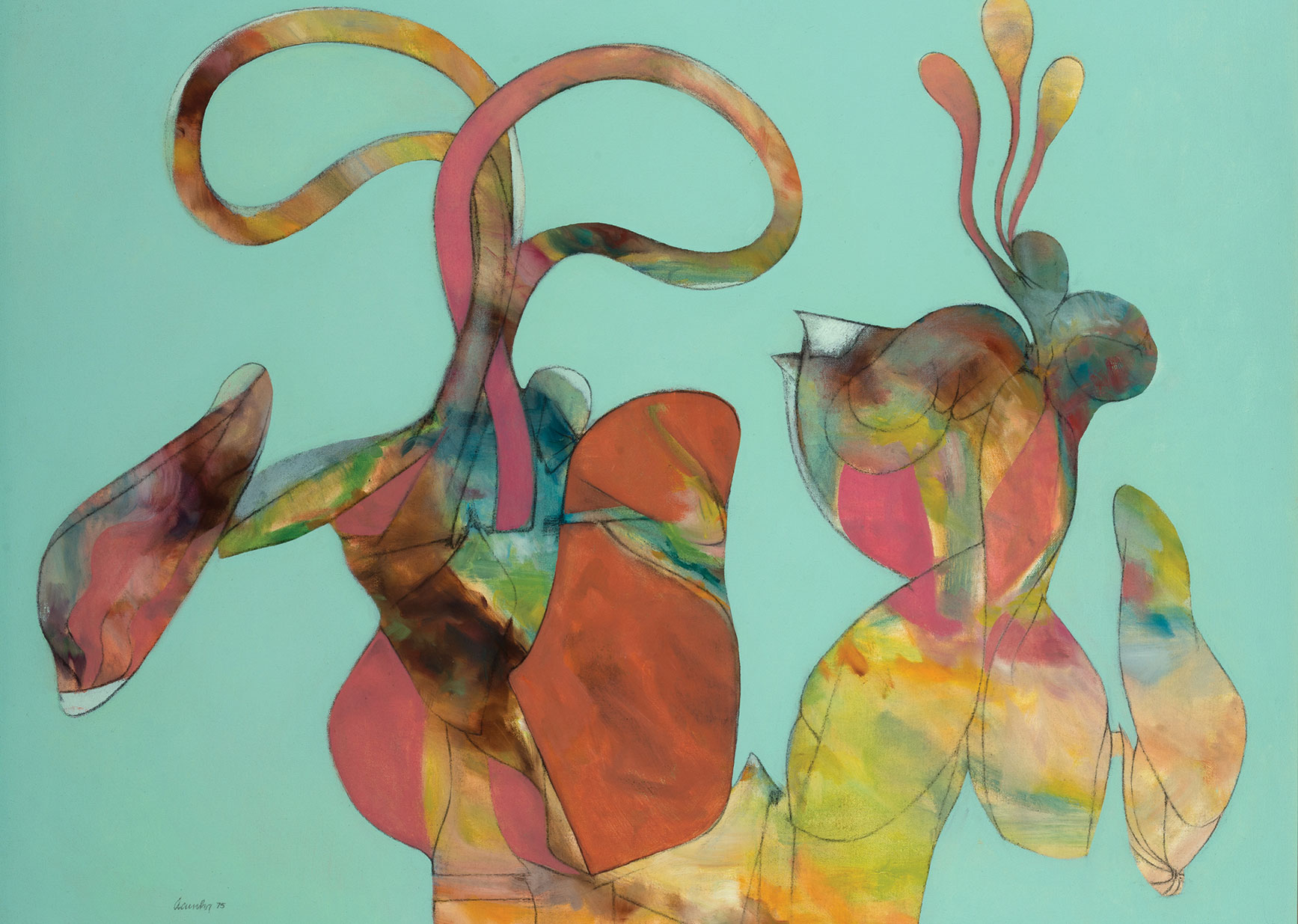The Delaware Art Museum is proud to continue spotlighting impactful local artists with its latest exhibition, Julio daCunha: Modernizing Myths, which opens Saturday, February 29, 2020 and runs until Sunday, May 10, 2020. DaCunha, who originally hails from Bogotá, Colombia, has a storied history in Delaware, teaching at the University of Delaware for nearly 40 years and exhibiting at several local and regional institutions, including the Delaware Art Museum.
Julio daCunha: Modernizing Myths, located in the Ammon Galleries and comprised of 40 works of art, including paintings, prints, and drawings, promises to be an exciting retrospective of a prolific, innovative artist and community leader whose work spans different styles. The 2019 Alfred Appel, Jr. Curatorial Fellow Olivia Armandroff, who organized this exhibition, says in her essay accompanying the exhibition, “Coming of age in the mid-20th century, in a period when artists were so often described as figurative or not, daCunha refused to be essentialized,” noting later that, “[a]lthough never devoting himself entirely to one style or the other, the majority of his work, mid-career was figural while his later artistic production was primarily devoted to abstraction.”
It is no surprise, then, to learn that daCunha worked in many mediums, including acrylic paint, oil paint, and graphite, and that his influences are wide-ranging, featuring a number of artistic luminaries. He counts Spanish artists such as Francisco de Goya as stylistic influences, while writers such as Charles Baudelaire and Edgar Allan Poe, along with femme fatale films, theater, music, and mythology—both classic and ones of his own making—largely inspired him thematically. In fact, daCunha was surrounded by art as a child. His mother was a musician, and his father was a diplomat, artist, and theater manager. It was through his father that he got to know the poet Pablo Neruda and famed artists Frida Kahlo and Diego Rivera. In a 1984 interview in The Review, a University of Delaware publication, daCunha says, “I made a little drawing for [Rivera]…and he gave me a drawing of a clown’s head which is now one of my most valuable possessions.”
Armandroff is deeply grateful for daCunha’s influence on Delaware and hopeful that he will continue to be a part of the lives of Delawareans. Julio daCunha helped shape the University of Delaware’s art department, and his teaching left an indelible mark on generations of students who went through that program.
“After arriving at the University of Delaware, he immediately involved himself in teaching students by instituting a very active exhibition schedule that brought traveling exhibitions to the university,” says Armandroff. “I was fascinated by daCunha’s investment in the American tradition, despite the fact that he had not grown up with it. I loved stories about his involvement with the local theater groups on campus and his dramatic flair. Most rewarding was hearing from his students, and after I began reaching out and contacting some, word on the exhibit quickly spread. People began to contact me, eager to share their own memories of Julio and his generosity as a mentor. Such narratives helped me begin to see the huge impact he had on the Delaware art community.”
Those who want to know more about daCunha and his work can hear more from Armandroff on Sunday, March 1 at 2:00 p.m. for a gallery talk. This event is free to attend. The exhibition is also accompanied by a free mini catalog featuring the aforementioned essay by Armandroff and full-color illustrations, available both at the exhibition gallery and in the Museum Store. The Museum Store will also be selling a selection of books by some of daCunha’s influences, including Charles Baudelaire and Edgar Allan Poe, as well as two exclusive cards featuring works of art from the exhibition.
About Julio daCunha
Julio daCunha was born in 1929 in Bogotá, Colombia. Following the completion of his master of fine arts degree at Cranbrook Academy of Art, daCunha arrived in Delaware in 1956 to teach at the University of Delaware. The artist places himself within the Spanish tradition and cites the influences of Arshile Gorky, Paul Klee, Pablo Picasso, Roberto Matta, and Francisco de Goya. While at the University, daCunha served as department chair from 1966 to 1969 and taught until his retirement in 1994.
PRESS CONTACT
Please contact Cynthia Smith, Marketing Manager, at csmith@delart.org or 302-351-8514.
ABOUT THE Distinguished Artist Series
The Distinguished Artist Series is a celebration of those artists who have impacted contemporary art in the greater Wilmington area through their artistic practices, teaching, and support of the community and its various institutions. Through unique exhibitions, the series will present exhibitions of these artists, surveying their legacies as they relate to local, national, and international trends.
ABOUT THE DELAWARE ART MUSEUM
For over 100 years, the Museum has served as a primary arts and cultural institution in Delaware. It is alive with experiences, discoveries, and activities to connect people with art and with each other. Originally created in 1912 to honor the renowned illustrator and Wilmington-native, Howard Pyle, the Museum’s collection has grown to over 12,000 works of art in our building and sculpture garden. Also recognized for British Pre-Raphaelite art, the Museum is home to the largest and most important Pre-Raphaelite collection outside of the United Kingdom and a growing collection of significant contemporary art.
Under the leadership of our Board of Trustees, the Delaware Art Museum is implementing a comprehensive approach to community and civic engagement. This exciting new strategic direction requires that we increase our value and relevance to all audiences. Visit delart.org to for the latest exhibitions, programs, and performances or connect with us via social media.


